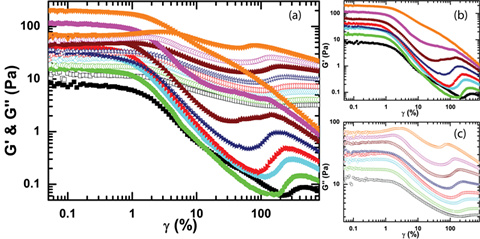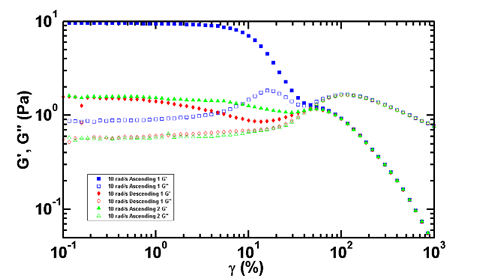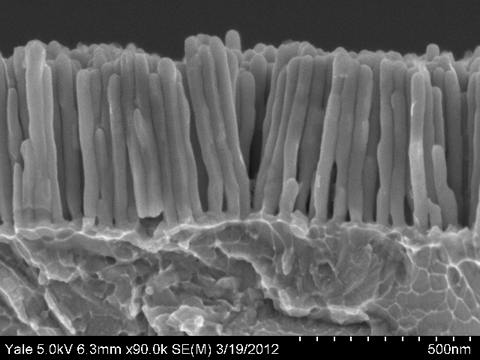|
Graduate Student Office: 226 Mason Lab Phone: (203) 436-4059 |
Since June 2009, PhD student, Yale University, School of Engineering & Applied Science, Department of Chemical Engineering August 2008, BSc in Polymer Science and Engineering, Zhejiang University, Department of Polymer Science and Engineering, BSc thesis: “Assembly of polymeric nano-particles with Breath Figure Method” |
|
My research in Prof. Chinedum Osuji's group is on the rheological properties of colloids and the thermophysical properties of bulk metallic glasses at the nanoscale. |
|
Project 1 Yielding and Shear Induced Structure Formation in Emulsions with Attractive Interactions |
|
The yielding behavior of dense colloidal suspensions is a strong function of the nature of the particle-particle interactions in the system. The addition of a non-adsorbing polymer to hard sphere colloidal glasses induces a short-range attraction and has been shown to lead to re-entrant behavior resulting in the formation of attractive colloidal glasses. Recent results [K. N. Pham, J. Rheol. 52(2), 649-679 (2008) ] indicate that such attractive colloidal glasses display a two-step yielding, as opposed to the single yielding transition observed in the hard sphere case. In this framework, the first yielding step at low strains corresponds to the breaking of attractive bonds between particles. The second yielding transition occurs at significantly larger strains and is attributed to a cage breaking process. From this perspective, we examine the yielding behavior of an oil-in-water emulsion system with attractive interactions using dynamic bulk rheology. In strain sweep experiments, the system shows a linear regime with constant elastic and viscous moduli at low strain values (<1%). On increasing strains beyond 1%, the system yields with a pronounced bump in the viscous modulus, a sharp decrease in the elastic modulus and a crossover between the two, indicating significant fluidization of the system. This one step yielding is different from the two-step yielding paradigm advanced for attractive particulate suspension systems. However, an increase in the complex modulus is observed at yet higher strains (~100%), with both the elastic and viscous components showing small peaks. The onset of this behavior is composition dependent with peaks shifting to lower strain values on increasing volume fraction of the dispersed phase. We speculate that this display is due to the formation of shear induced structures in these systems at high strains. |
|
 |
|
Fig. 1 Strain sweep tests done for samples containing 25% Pluronic F68 and 10% TX-100 in
aqueous phase but different oil volume fraction from 25% to 65%. In each subplot, from bottom
to top, content of oil increases. Solid symbols represent storage modulus G′ and open symbols are for loss modulus G". |
|
Project 2 Suspension rheology of deformable particles |
|
The rheology of particulate suspensions has been observed to be a strong function of particle deformability. For example, the shear thinning of red blood cell suspensions is shown to increase with an increase in the deformability of the cell membrane, with important implications for circulatory behavior. Likewise, shear thickening is nearly ubiquitous in concentrated suspensions of rigid particles but almost absent in suspensions of softer, more deformable objects. However, we still lack a comprehensive description of the role of particle deformability in suspension rheology. This is due in large part to the difficulty of systematically and independently varying particle rigidity, volume fraction, interaction strength and size. From this perspective, my Ph. D thesis focuses on the synthesis and the characterization of a colloidal system that permits such variation. The system will contain thermosensitive particles, which will behave like liquids or solids at different temperatures. Potential materials can be polymer solutions and polymer glasses. We will report an informative study of elasticity and viscosity of deformable particles over a broad range of volume fraction, with various particles sizes and different inter-particle forces. Due to the complete separation of variables and comprehensive database, we will be able to establish a mechanism or a theory to explain and predict the behaviors of suspensions influenced by the deformability. |
|
Project 3 Rheological Behavior of Polymer Grafted Titanium dioxide |
|
The flow properties of suspensions are determined by the total inter-particle potential composed of an attractive part and a replusive part. The environmental conditions can change the total potential and therefore influence the flow propeties of suspensions. In this context, we studied the rheological behaviors of titanium dioxide suspensions grafted by a zwitterionic polymer, methyl phasphotidylcholine, at different pH and in the presence of ions, ionic surfactants and noninonic surfactant. It is found that suspensions are destablized by ions, low pH, cationic surfactants and large amount of all of the surfactants and that they are stablized by high pH and anionic surfactants. The stability of the system is explained based on the total potential influenced by these factors. |
|
 |
|
Fig. 2 Effect of low pH on viscosity |
|
Project 4 Yielding in Attractive Microgel Suspensions |
|
The yielding behavior of colloidal suspensions is a strong function of the nature of the particle-particle interactions in the system. Due to electrostatic interactions between negatively charged carboxylic acid groups, suspensions of Carbopol microgel particles behave as repulsive systems at elevated pH where the acid groups are well deprotonated. This electrostatic repulsion may be screened at sufficiently high ionic strength, resulting in a net attractive interaction between particles and the formation of colloidal gels due to particle aggregation. We examine the yielding behavior of Carbopol suspensions in the transition from a soft jammed glassy suspension to an attractive colloidal gel by varying the ionic strength of the suspensions through salt (NaCl) addition. A clear transition from simple one-step yielding to two-step around yield strain with two prominent peaks of loss modulus in strain sweep tests is found with increasing NaCl concentration. The magnitude and location of the two peaks in the loss modulus show different frequency dependences and are markedly different in their reversibility, that is, in their dependence on sample history. Whereas repulsive systems yield by simple particle cage escape, further data showed that attractive systems yield by one step which combines bond rupture and cage-breaking and structure formation is induced right after yielding. |
|
 |
|
| Fig. 3 Ascending and descending strain sweep tests on 0.5wt% carbopol microgel in 0.15 M NaCl solution. The magnitude and location of the two peaks in the loss modulus are markedly different in their reversibility. The second peak is maintained in the descending test as it originates from hydrodynamic, in the contrast, the first peak, which disappears in the descending curve, is more time dependent as it may be induced by bond rupture and cage-breaking. | |
Project 5 Size Effects in Bulk Metalic Glass |
|
The bulk metallic glass we are studying in can be imprinted into features as small as 10 nm with aspect ratio up to 50. The ability to precisely fabricate BMGs on such small scales allows us to study size effects on deformation, strength, and viscosity. |
|
 |
|
Fig. 4 Cross-sectional image of bulk metalic glass rods made from 18 nm AAO template |
|
|
|
|
|
|
|
|
